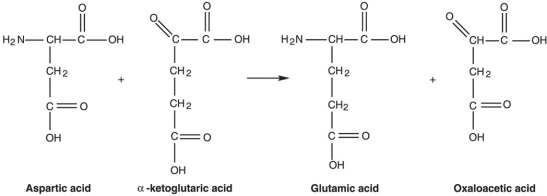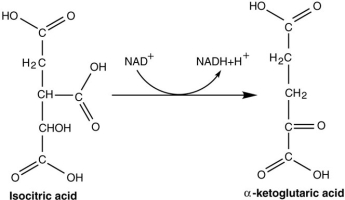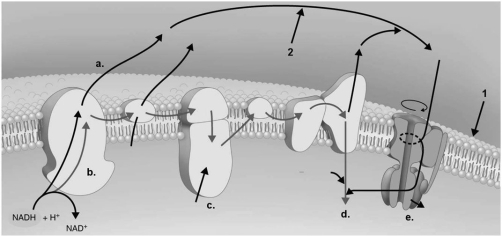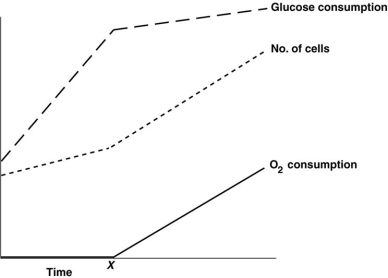Correct Answer

verified
Correct Answer
verified
Multiple Choice
Microorganisms that catabolize sugars into ethanol and hydrogen gas would most likely be categorized as
A) anaerobic respirers.
B) homolactic fermenters.
C) alcohol fermenters.
D) aerobic respirers.
E) heterolactic fermenters.
Correct Answer

verified
Correct Answer
verified
Multiple Choice
If a cell is starved for ATP, which of the following pathways would most likely be shut down?
A) Krebʹs cycle
B) pentose phosphate pathway
C) glycolysis
D) Krebs cycle and glycolysis
Correct Answer

verified
Correct Answer
verified
Not Answered
You look in the refrigerator and find some orange drink you had forgotten was there. The drink now has an ʺoffʺ taste and bubbles. What is the most likely explanation for the changes in the drink?
Correct Answer

verified
Correct Answer
verified
True/False
In general, ATP is generated in catabolic pathways and expended in anabolic pathways.
Correct Answer

verified
Correct Answer
verified
Multiple Choice
Figure 5.7  The graph at the left in Figure 5.7 shows the reaction rate for an enzyme at its optimum temperature. Which graph shows enzyme activity at a higher temperature?
The graph at the left in Figure 5.7 shows the reaction rate for an enzyme at its optimum temperature. Which graph shows enzyme activity at a higher temperature?
A) a
B) b
C) c
D) d
Correct Answer

verified
Correct Answer
verified
Multiple Choice
Figure 5.2  What type of reaction is in Figure 5.2?
What type of reaction is in Figure 5.2?
A) decarboxylation
B) dehydrogenation
C) oxidation
D) reduction
E) transamination
Correct Answer

verified
Correct Answer
verified
Multiple Choice
Which of the following compounds is NOT an enzyme?
A) dehydrogenase
B) sucrase
C) cellulase
D) β-galactosidase
E) coenzyme A
Correct Answer

verified
Correct Answer
verified
True/False
An apoenzyme that loses its coenzyme subunit will be non -functional.
Correct Answer

verified
Correct Answer
verified
Multiple Choice
Fatty acids are oxidized in
A) the Krebs cycle.
B) the Entner-Doudoroff pathway.
C) the pentose phosphate pathway.
D) the electron transport chain.
E) glycolysis.
Correct Answer

verified
Correct Answer
verified
Multiple Choice
Assume you are working for a chemical company and are responsible for growing a yeast culture that produces ethanol. The yeasts are growing well on the maltose medium but are not producing alcohol. What is the most likely explanation?
A) Not enough protein is provided.
B) o2 is in the medium.
C) The temperature is too low.
D) The temperature is too high.
E) The maltose is toxic.
Correct Answer

verified
Correct Answer
verified
Multiple Choice
Figure 5.4  How is ATP generated in the reaction shown in Figure 5.4?
How is ATP generated in the reaction shown in Figure 5.4?
A) glycolysis
B) oxidative phosphorylation
C) photophosphorylation
D) fermentation
E) substrate-level phosphorylation
Correct Answer

verified
Correct Answer
verified
Multiple Choice
Figure 5.1  Which compound is being reduced in the reaction shown in Figure 5.1?
Which compound is being reduced in the reaction shown in Figure 5.1?
A) α-ketoglutaric acid and NAD+
B) NADH and isocitric acid
C) NADH
D) isocitric acid and α-ketoglutaric acid
E) NAD+
Correct Answer

verified
Correct Answer
verified
Multiple Choice
Figure 5.8
 -In Figure 5.8, the path labeled ʺ2ʺ is the flow of
-In Figure 5.8, the path labeled ʺ2ʺ is the flow of
A) energy.
B) electrons.
C) water.
D) protons.
E) glucose.
Correct Answer

verified
Correct Answer
verified
Multiple Choice
Which of the following statements about substrate-level phosphorylation is FALSE?
A) It occurs in glycolysis.
B) It involves the direct transfer of a high-energy phosphate group from an intermediate metabolic compound to ADP.
C) No final electron acceptor is required.
D) It occurs to a lesser degree in the Krebs cycle than in glycolysis.
E) The oxidation of intermediate metabolic compounds releases energy that is used to generate ATP.
Correct Answer

verified
Correct Answer
verified
Multiple Choice
A bacterial culture grown in a glucose-peptide medium causes the pH to increase. The bacteria are most likely
A) oxidizing the glucose.
B) not growing.
C) using the peptides.
D) fermenting the glucose.
Correct Answer

verified
Correct Answer
verified
True/False
Catabolic reactions are generally degradative and hydrolytic.
Correct Answer

verified
Correct Answer
verified
Multiple Choice
Which of the following statements are TRUE? 1- Electron carriers are located at ribosomes. 2- ATP is a common intermediate between catabolic and anabolic pathways. 3- ATP is used for the long-term storage of energy and so is often found in storage granules. 4-Anaerobic organisms are capable of generating ATP via respiration. 5-ATP can be generated by the flow of protons across protein channels.
A) 1, 2, 3
B) 1, 3, 4
C) 2, 4, 5
D) 2, 3, 5
E) All of the statements are true.
Correct Answer

verified
Correct Answer
verified
Multiple Choice
Figure 5.6  The rates of o2 and glucose consumption by a bacterial culture are shown in Figure 5.6. Assume a bacterial culture was grown in a glucose medium without o2. Then o2 was added at the time marked X. The data indicate that
The rates of o2 and glucose consumption by a bacterial culture are shown in Figure 5.6. Assume a bacterial culture was grown in a glucose medium without o2. Then o2 was added at the time marked X. The data indicate that
A) these bacteria cannot grow anaerobically.
B) these bacteria get more energy anaerobically.
C) aerobic metabolism is more efficient than fermentation.
D) these bacteria donʹt use o2.
Correct Answer

verified
Correct Answer
verified
Multiple Choice
Figure 5.8
 -Refer to Figure 5.8. In aerobic respiration, where is water formed?
-Refer to Figure 5.8. In aerobic respiration, where is water formed?
A) a
B) b
C) c
D) d
E) e
Correct Answer

verified
Correct Answer
verified
Showing 41 - 60 of 64
Related Exams